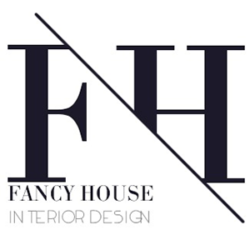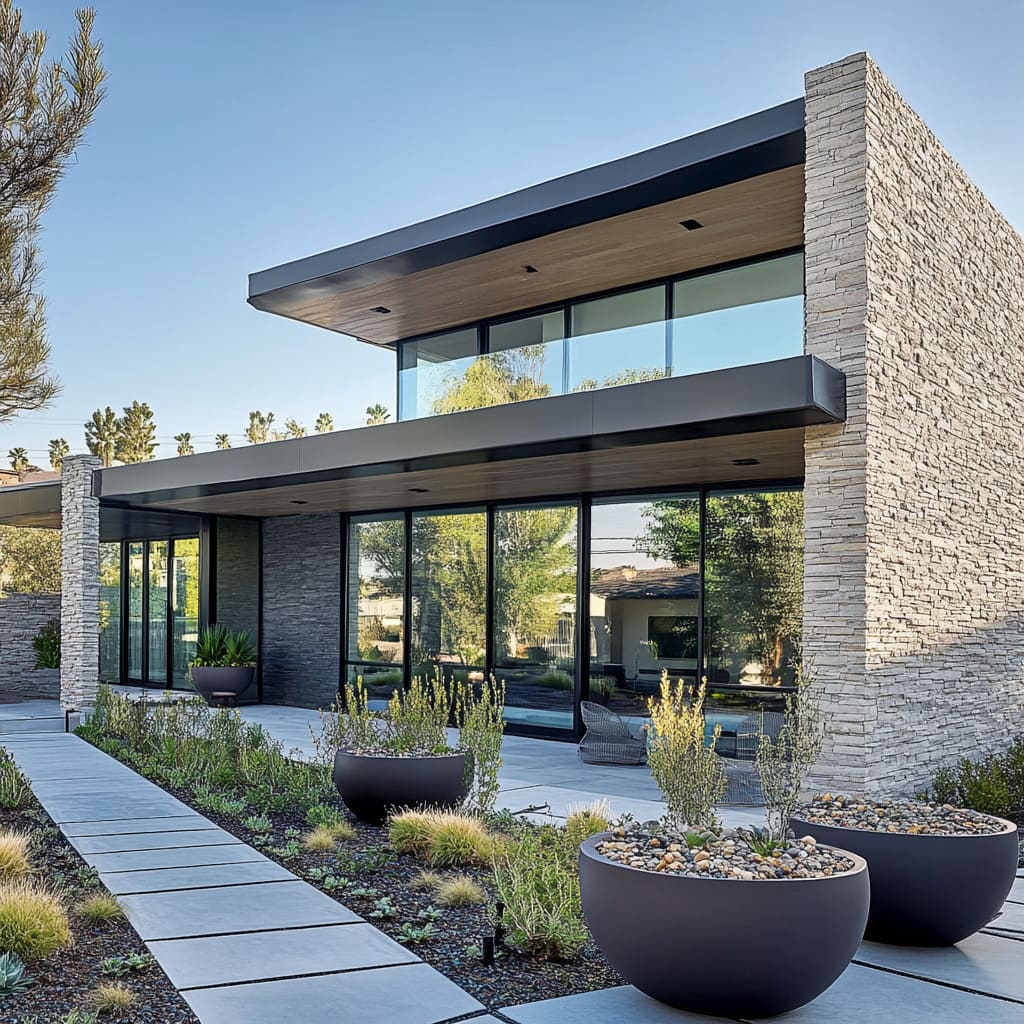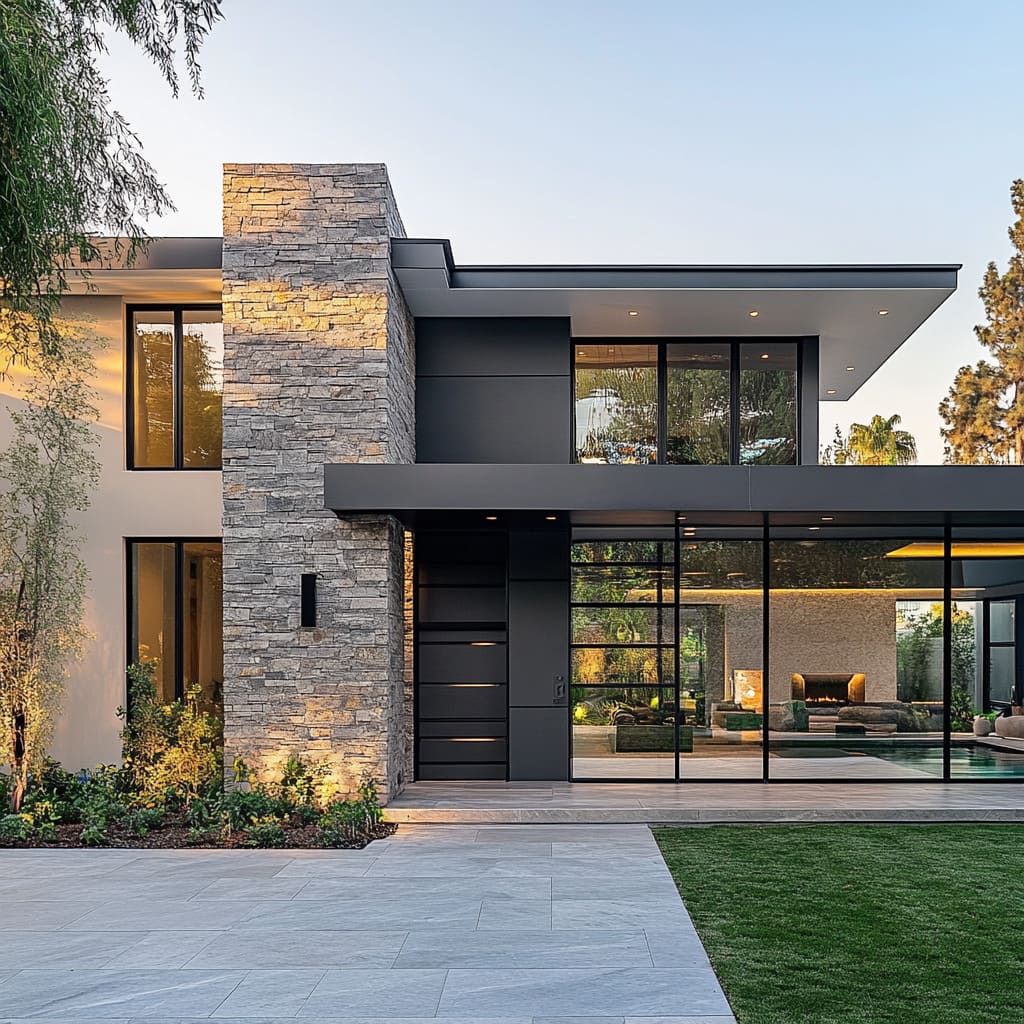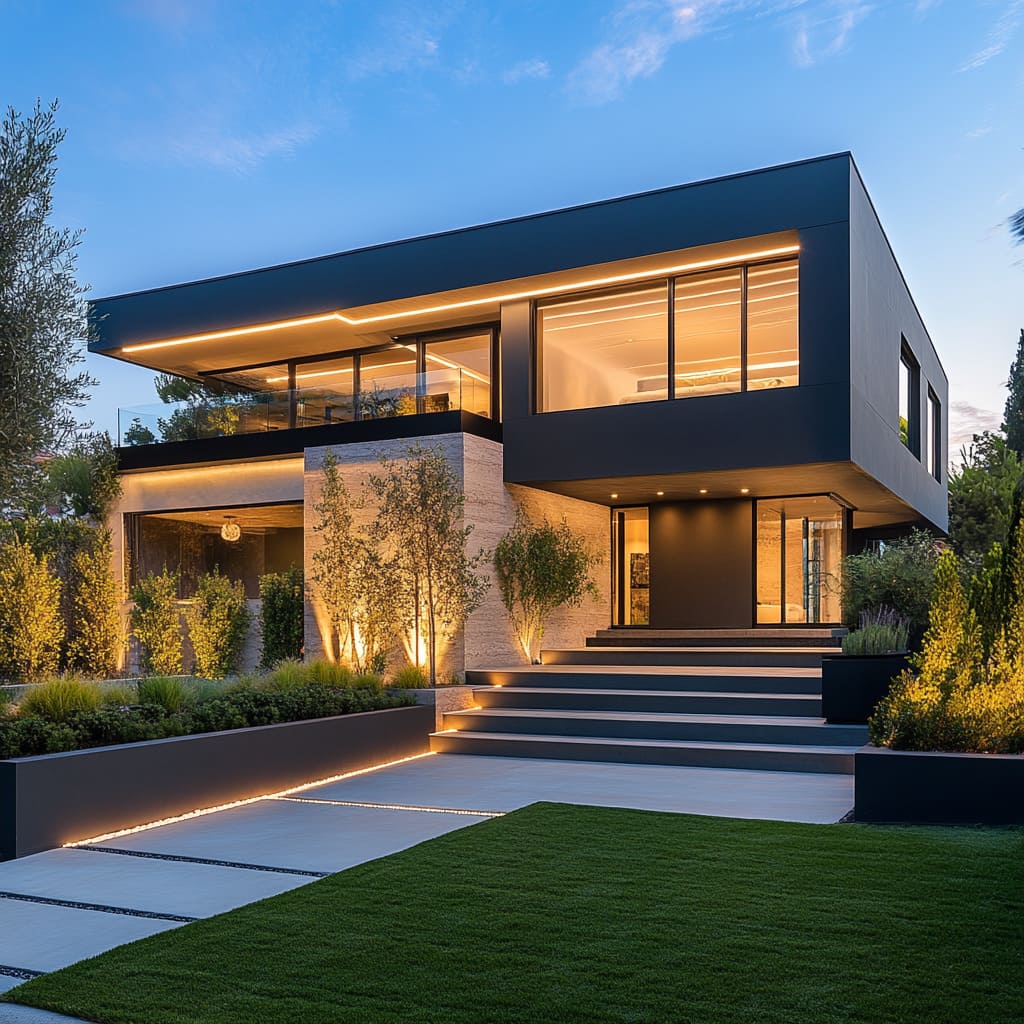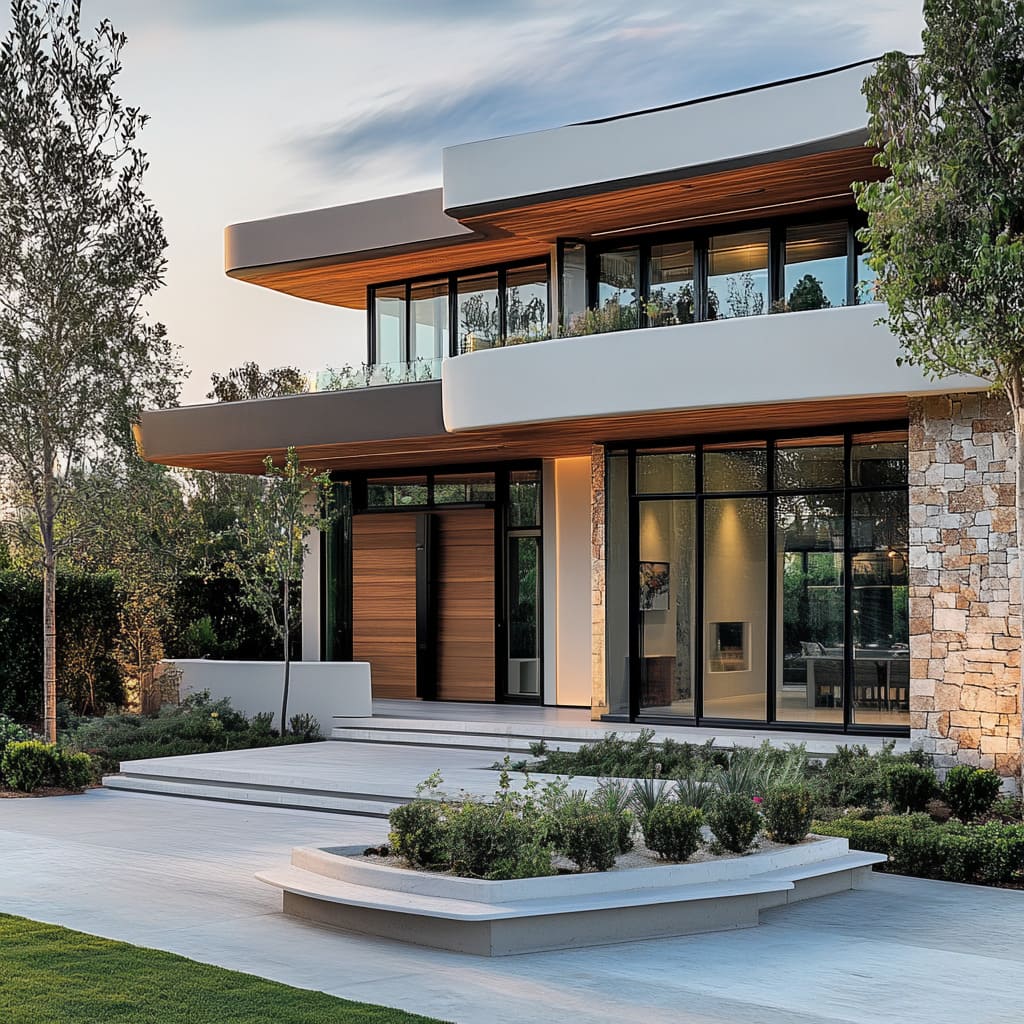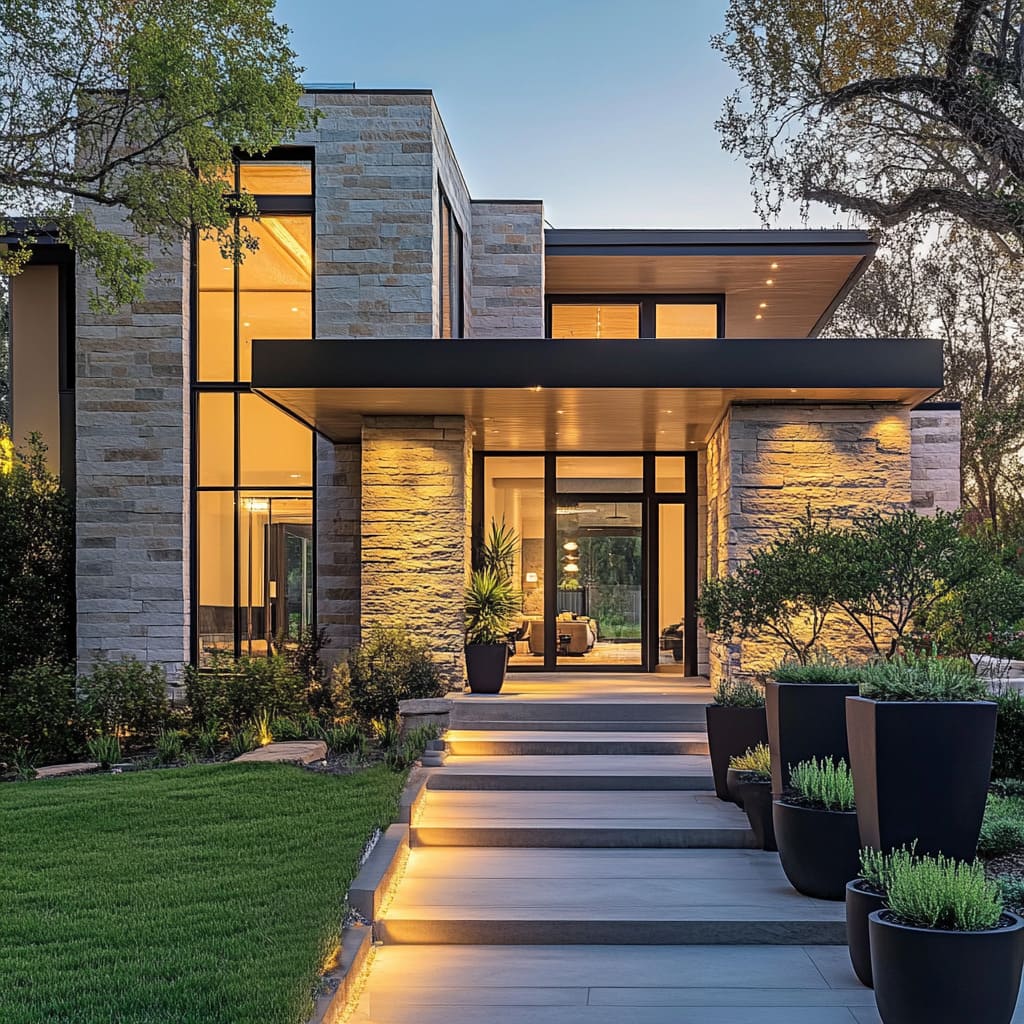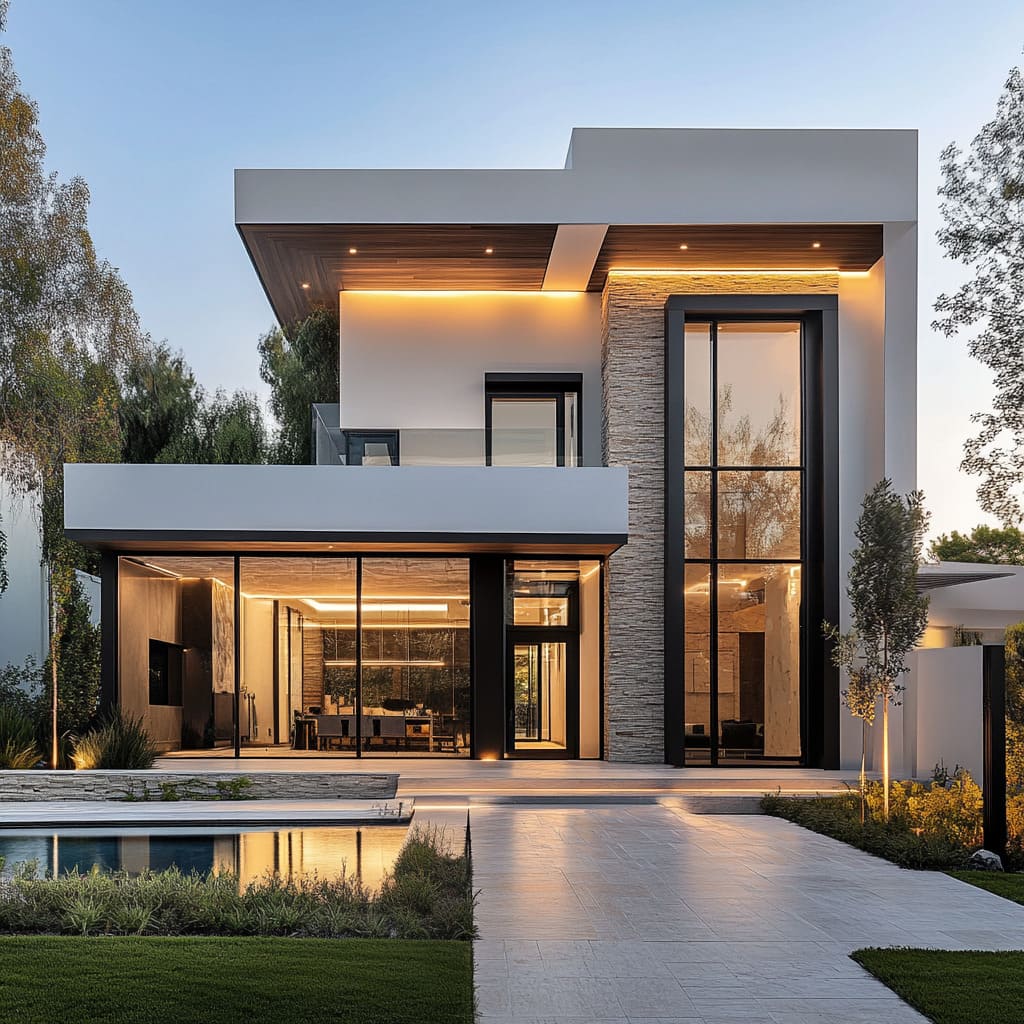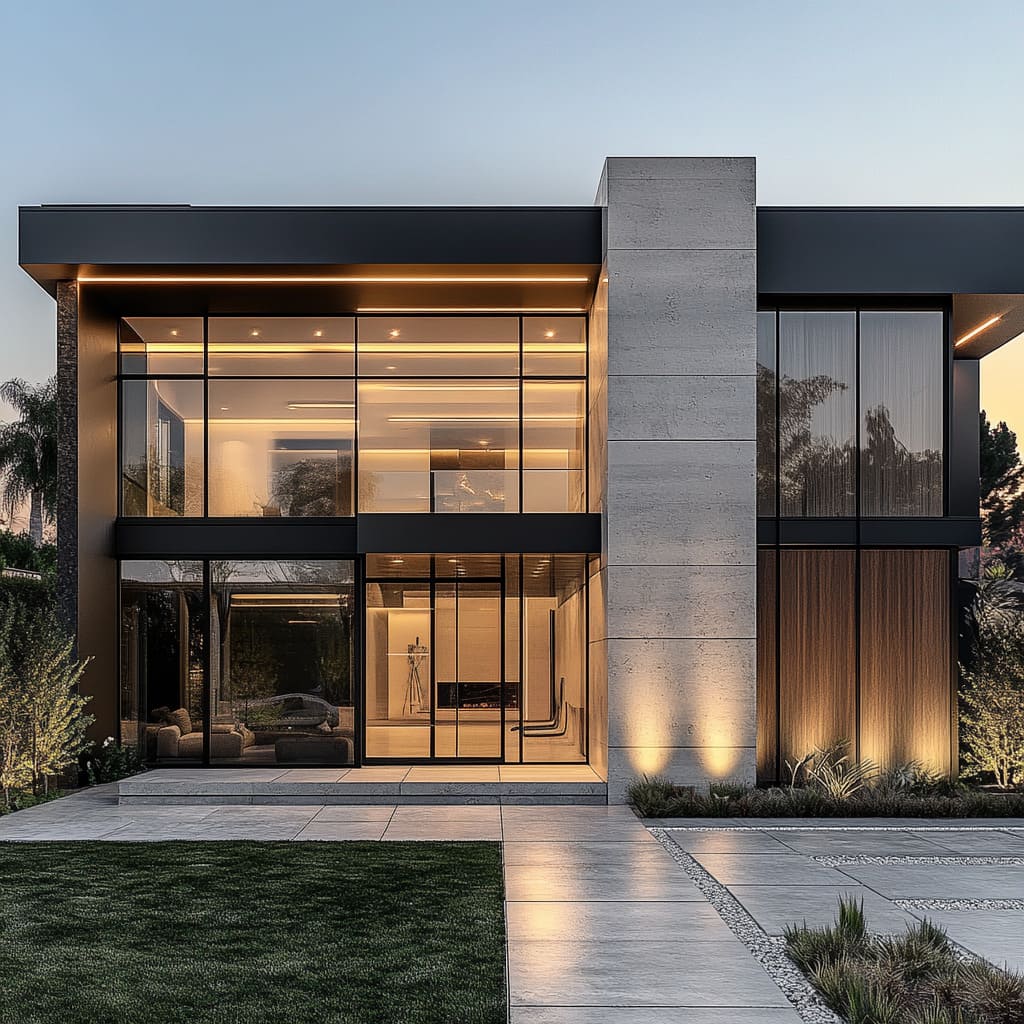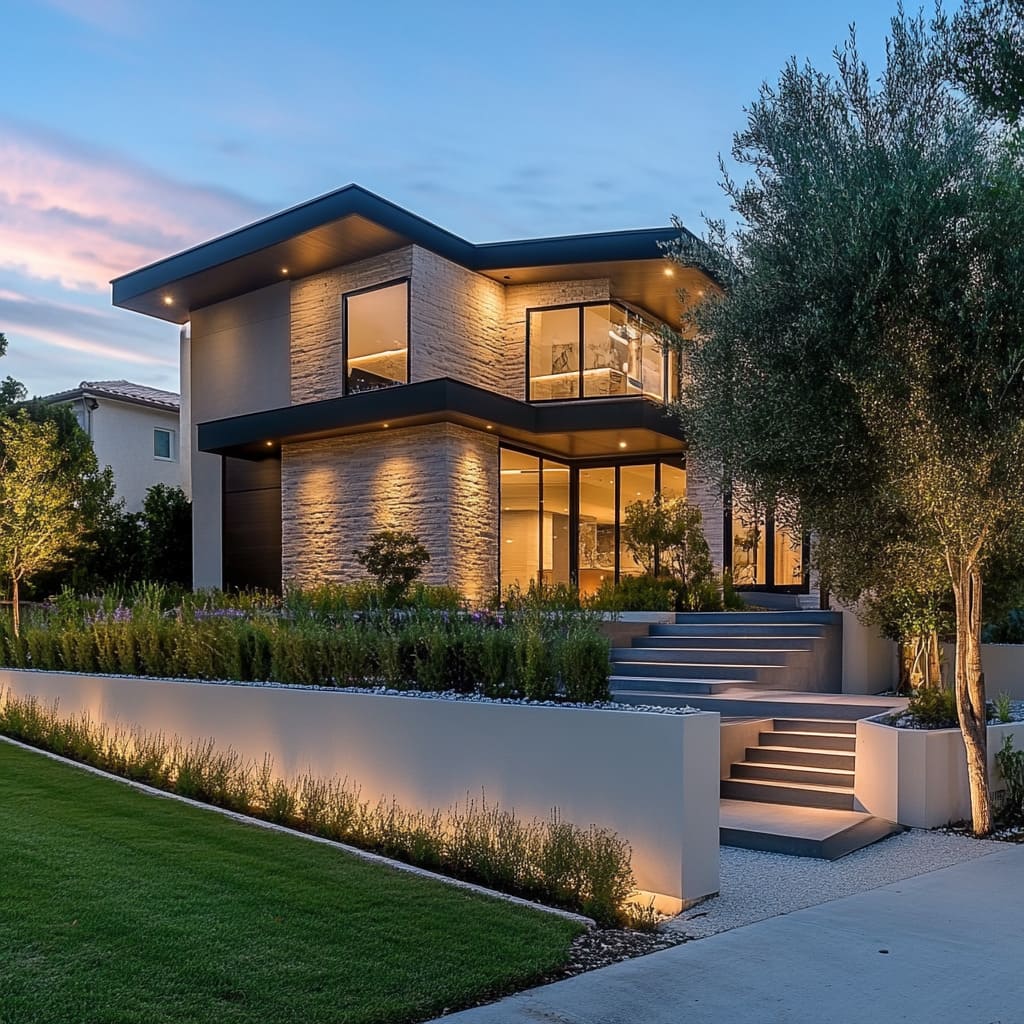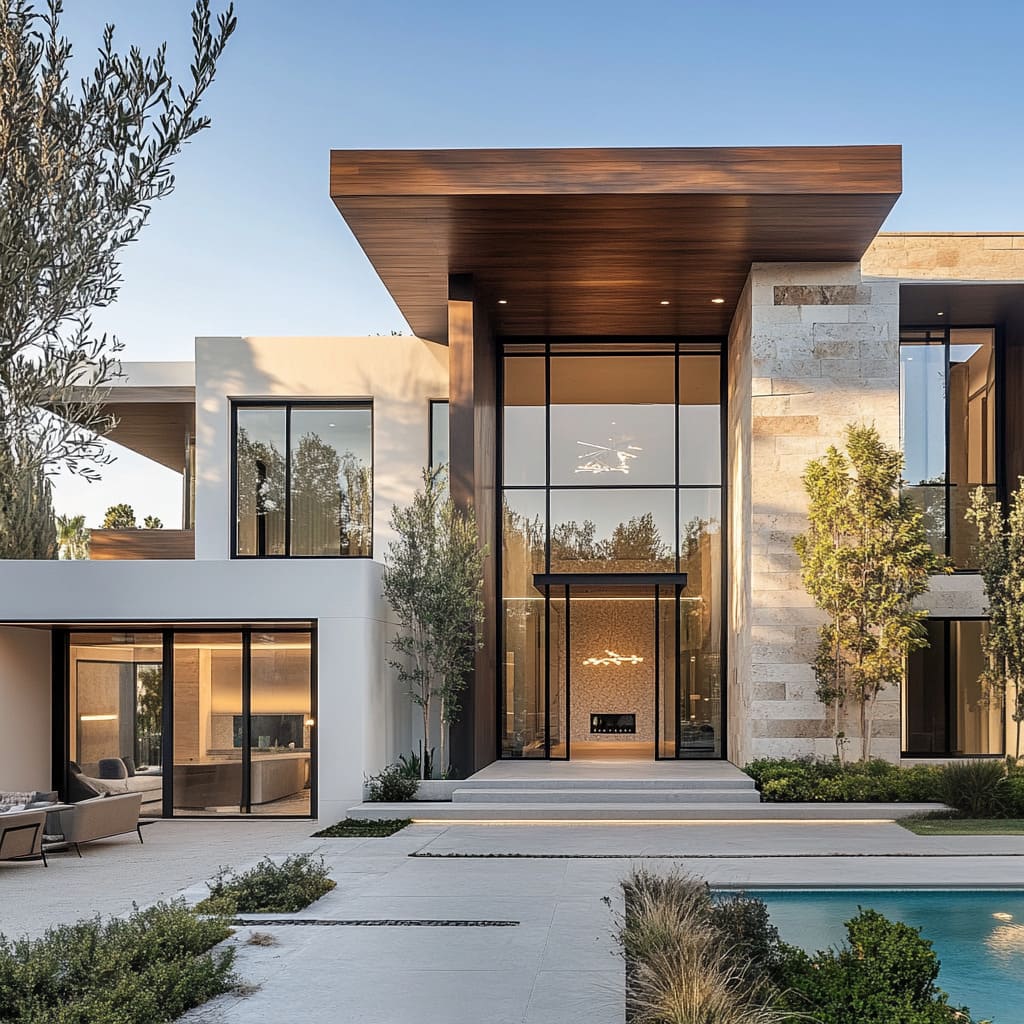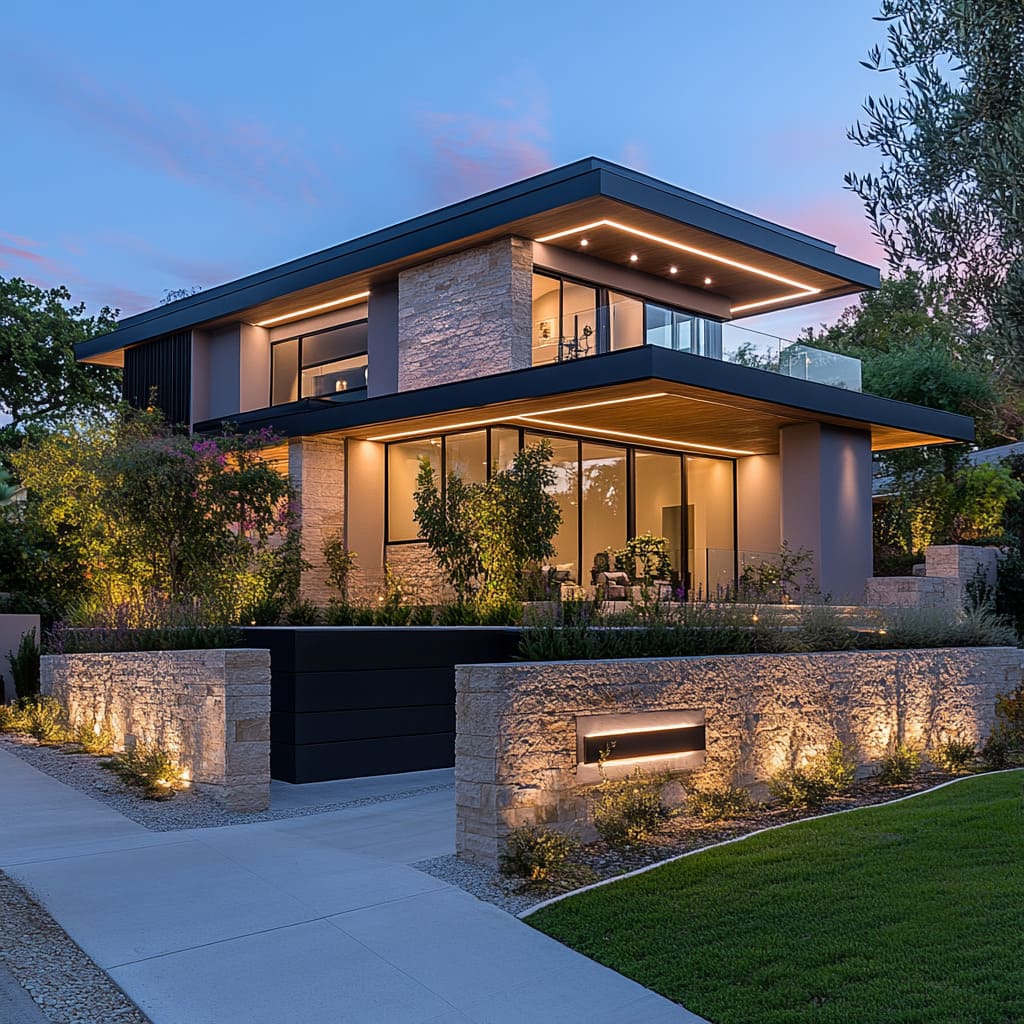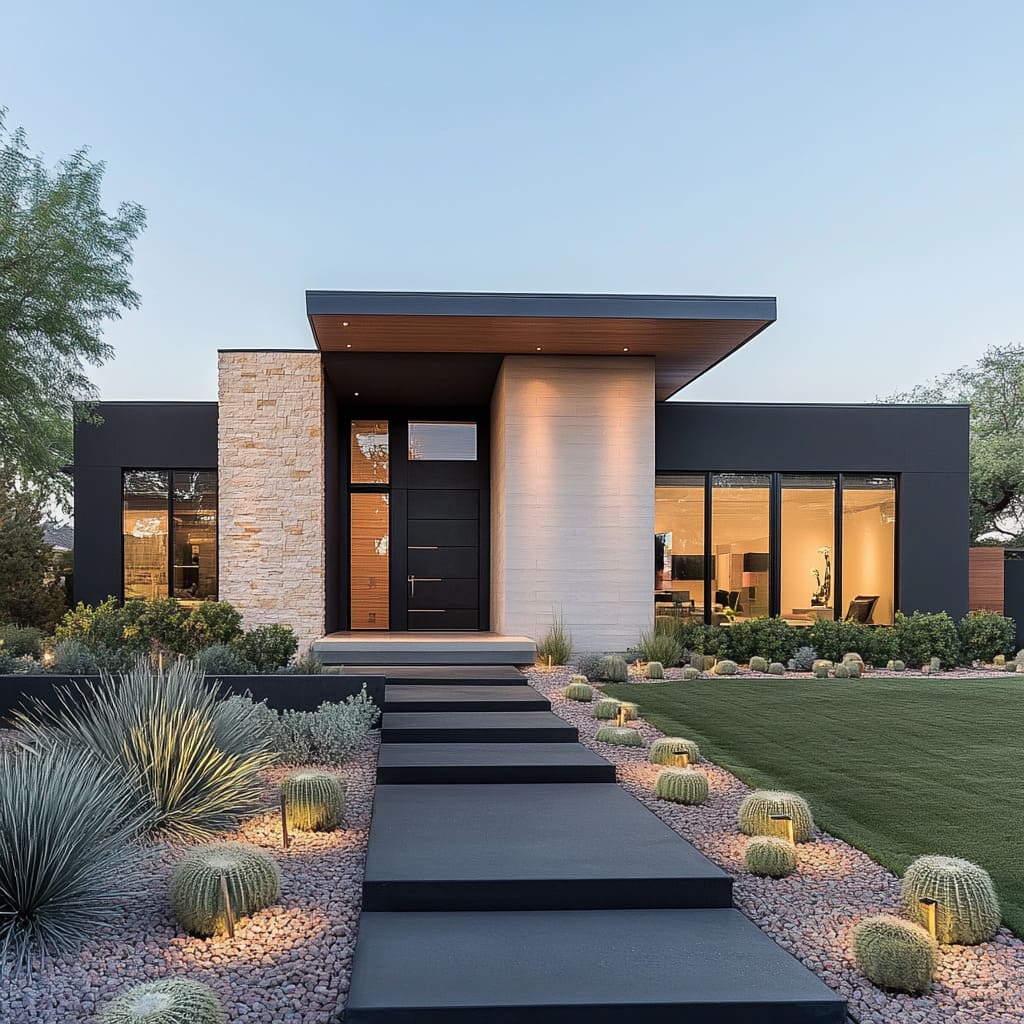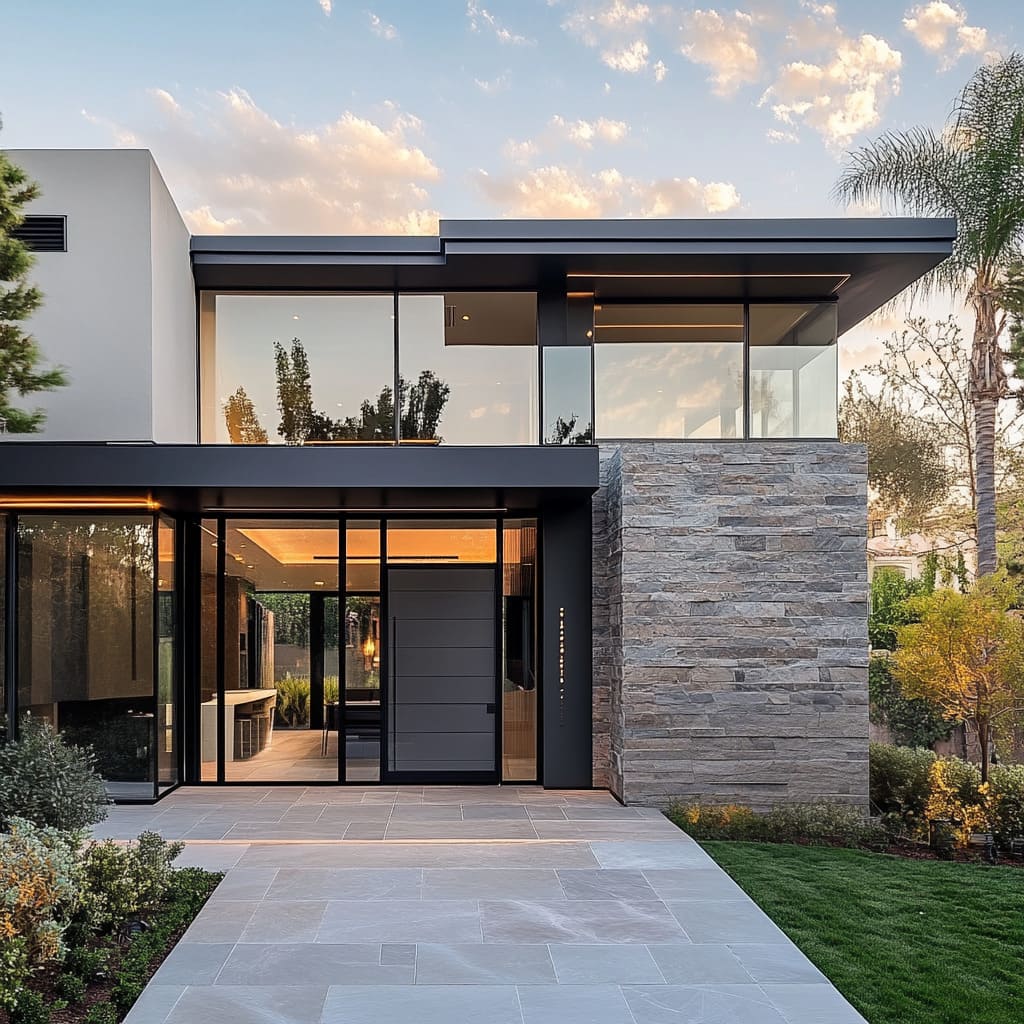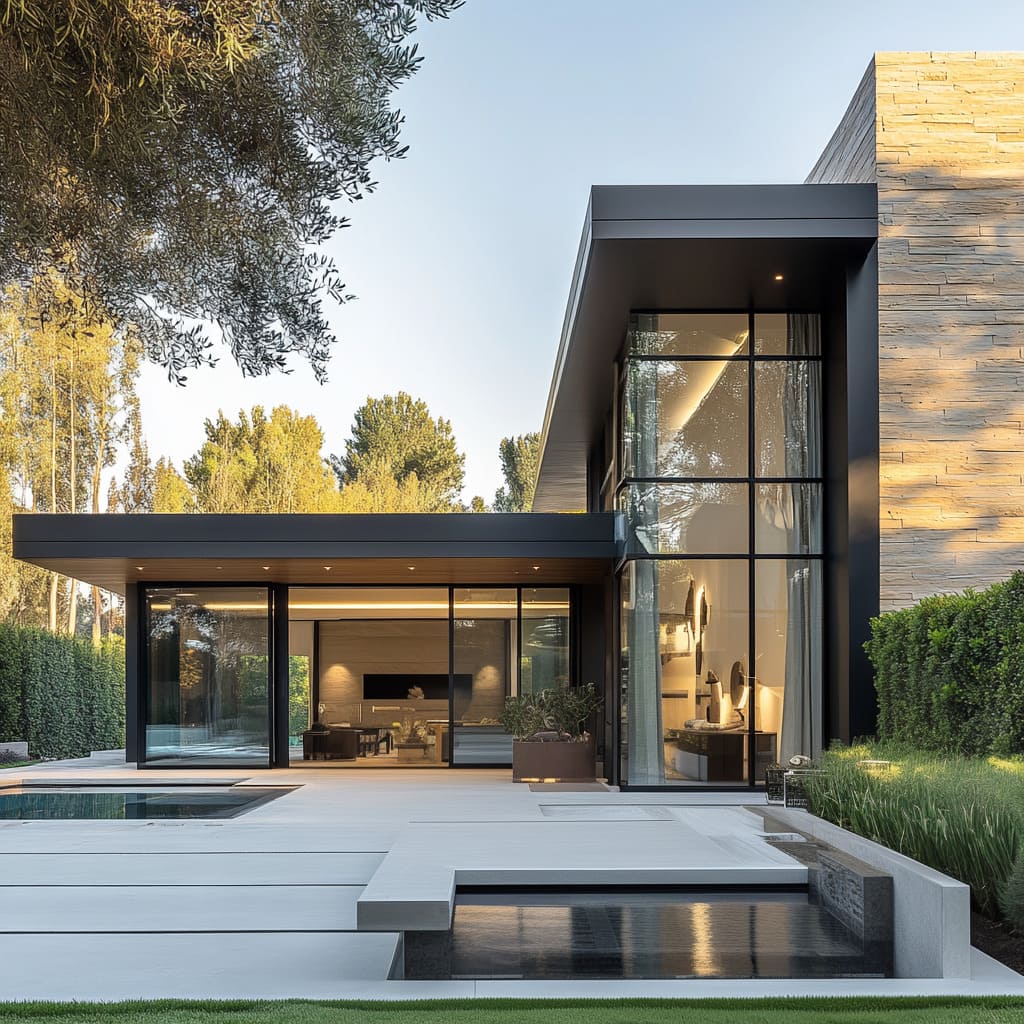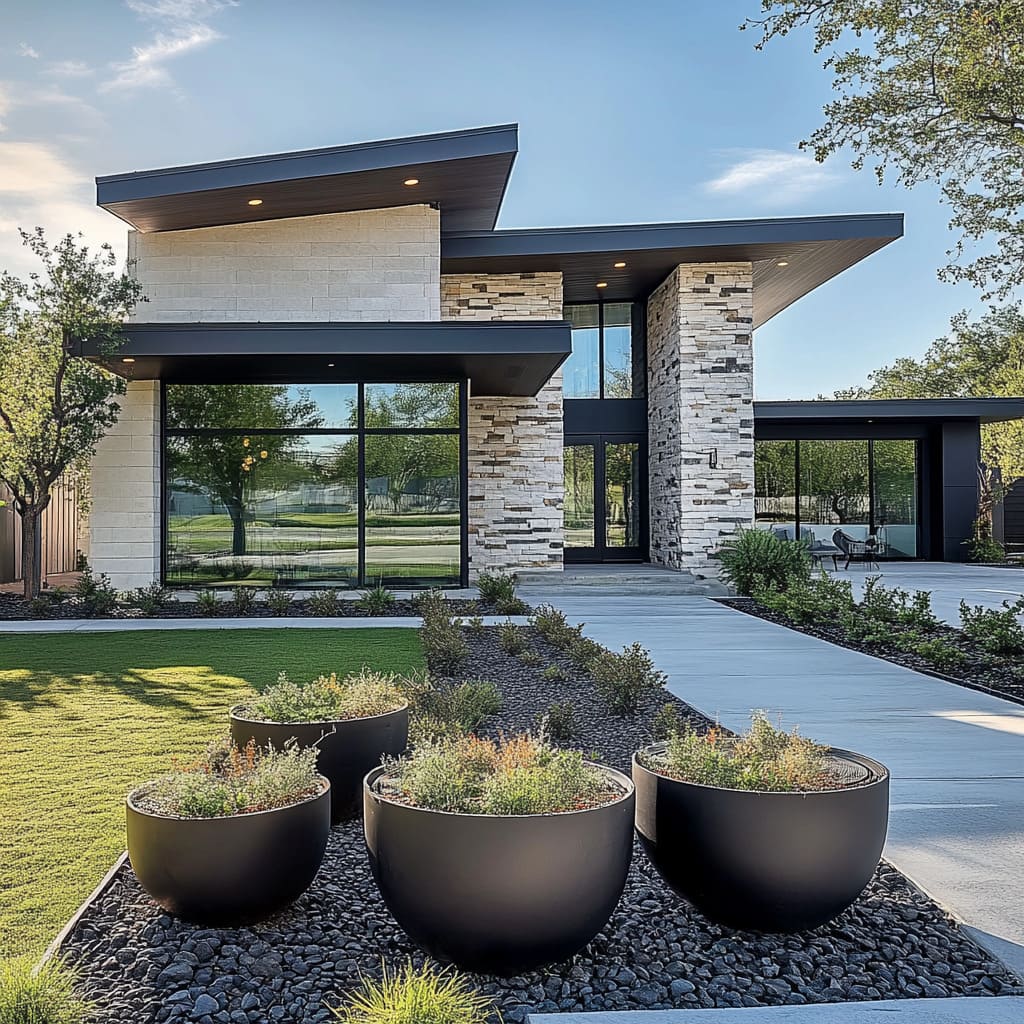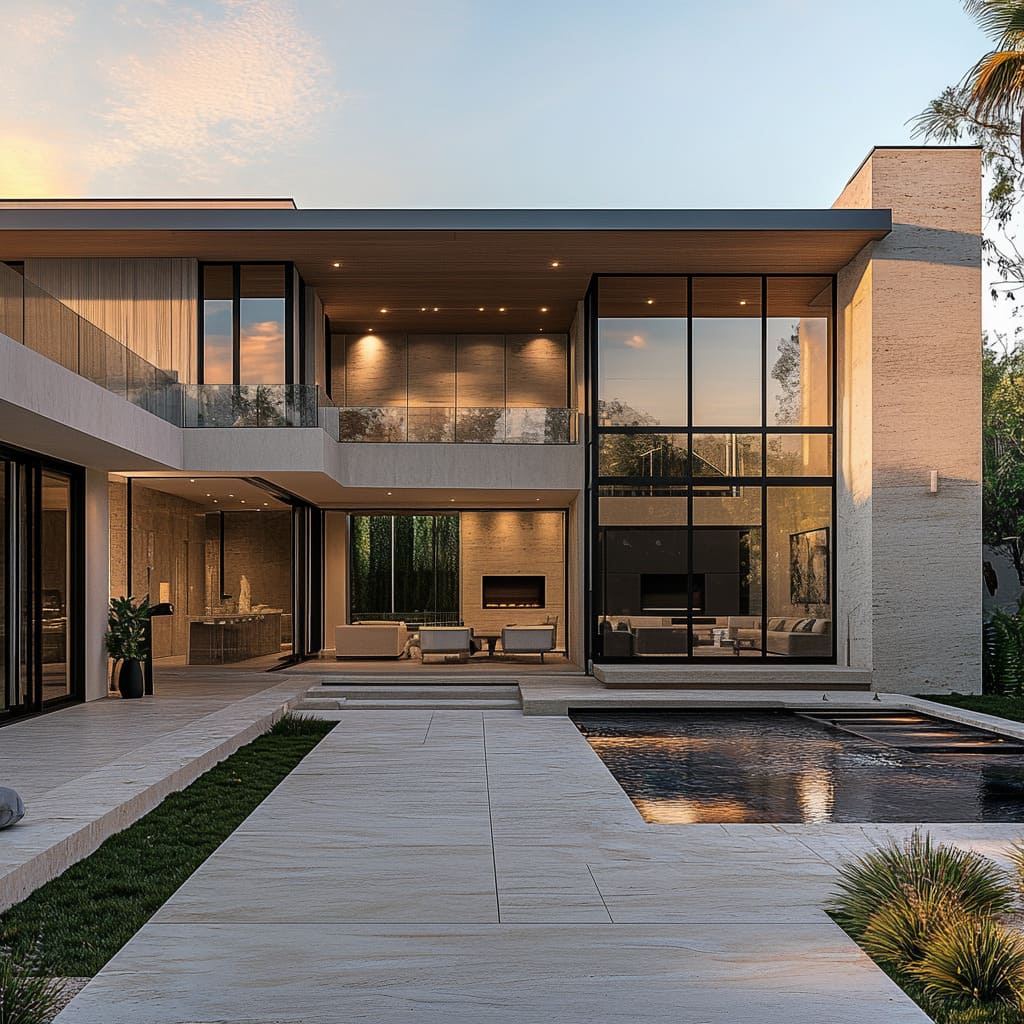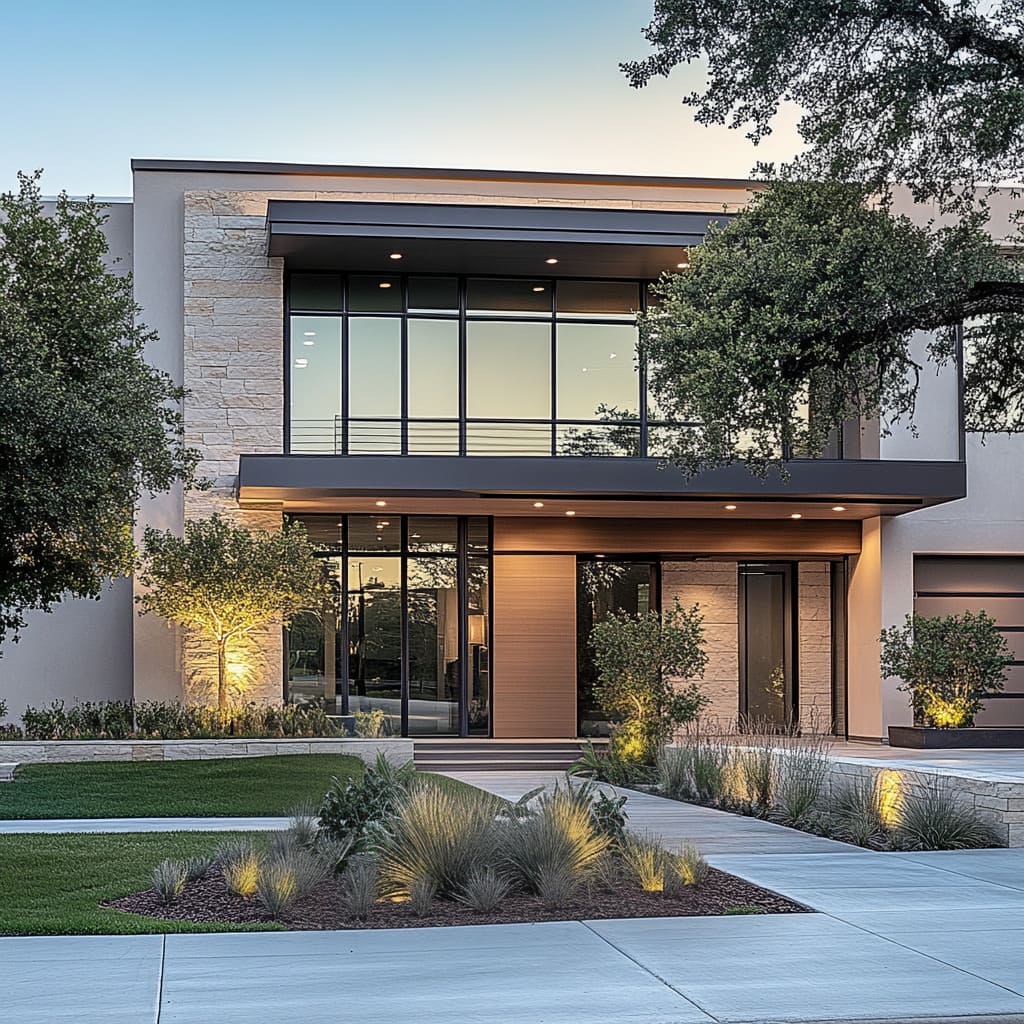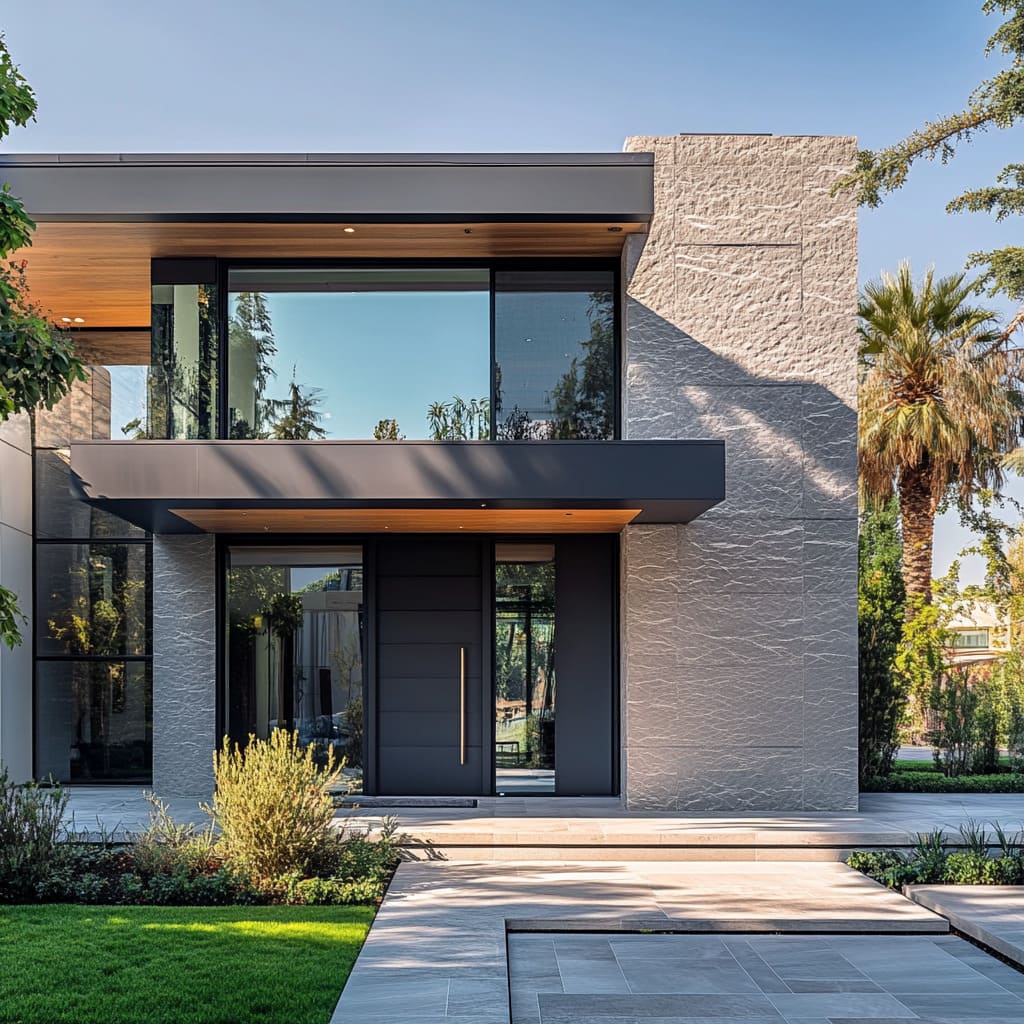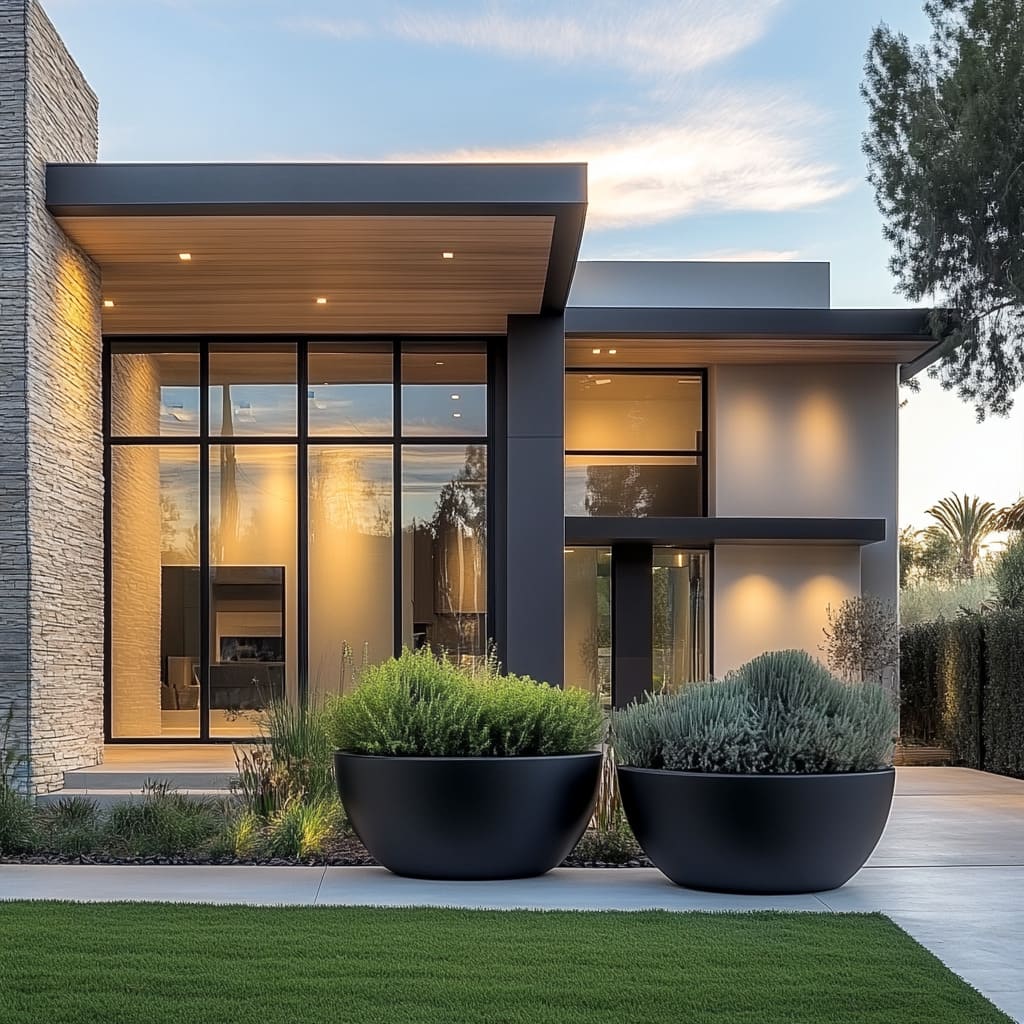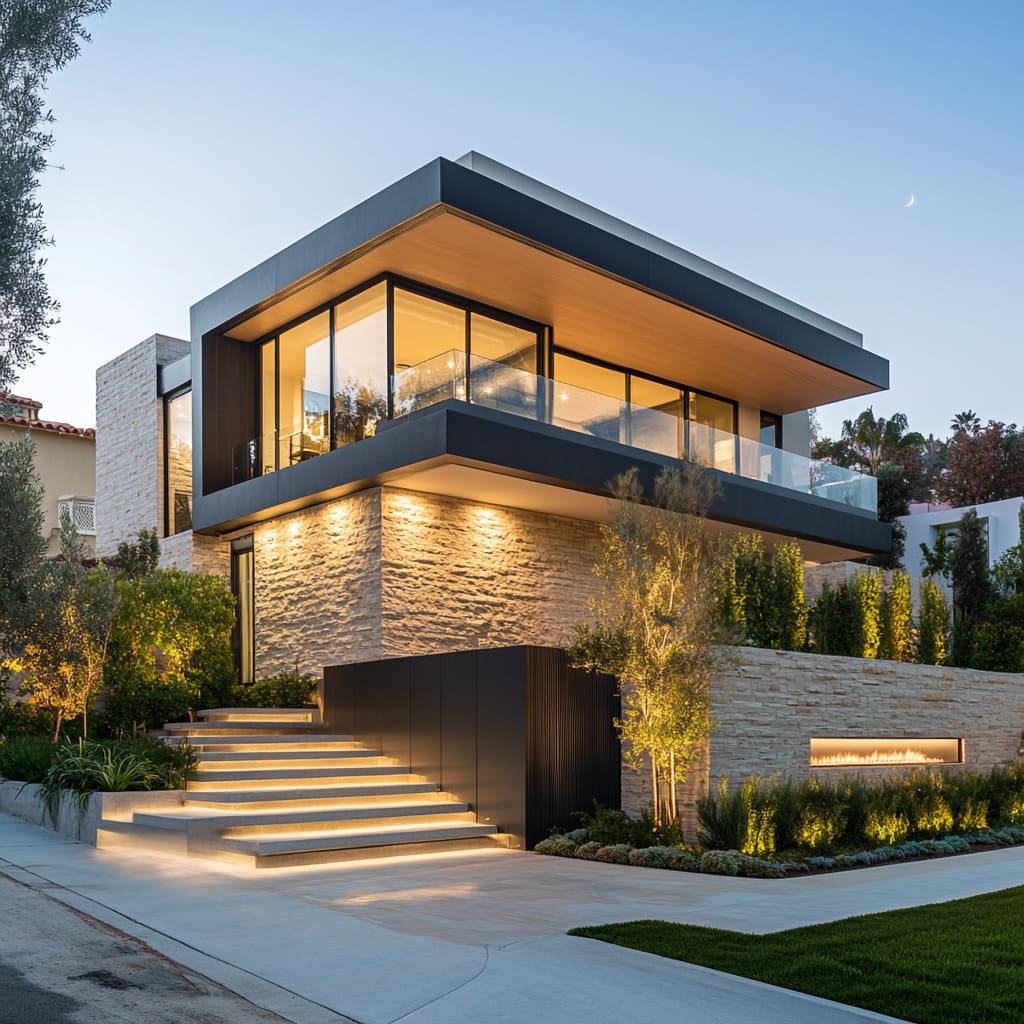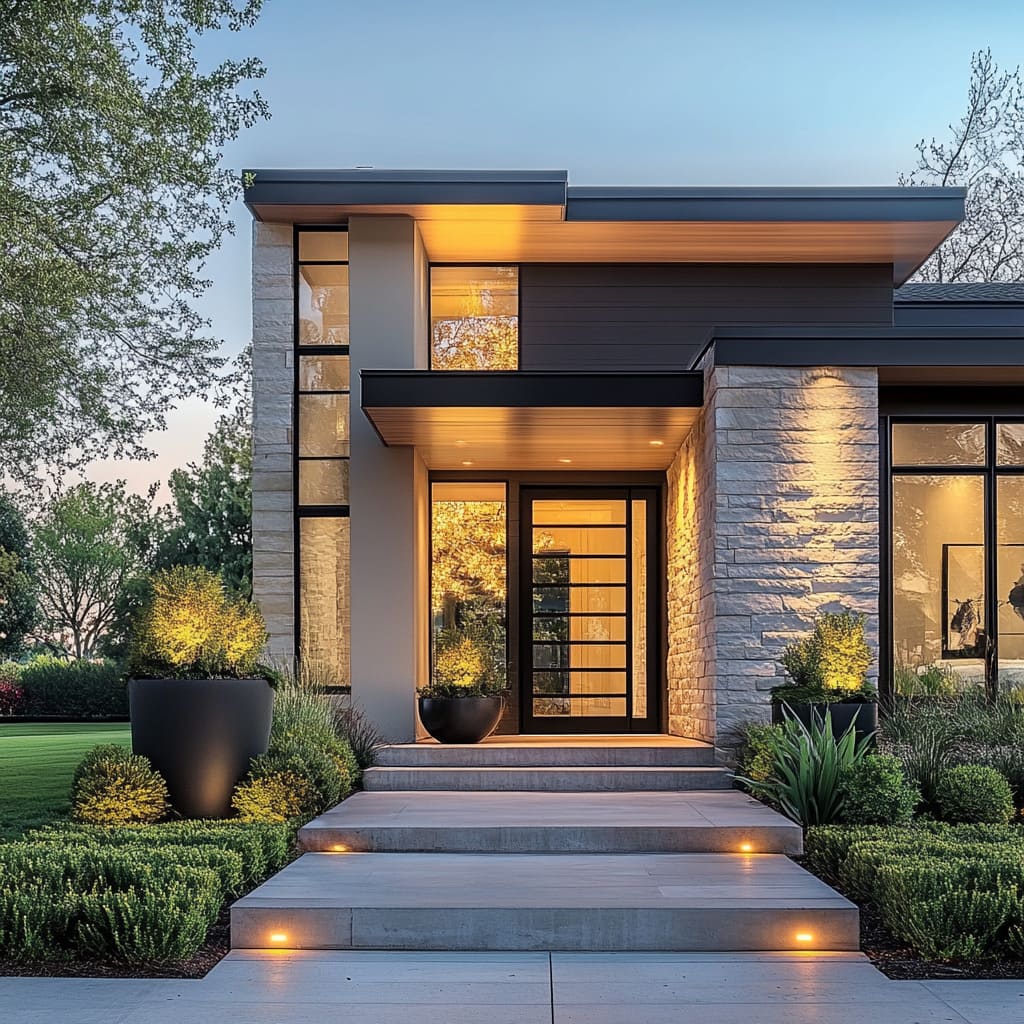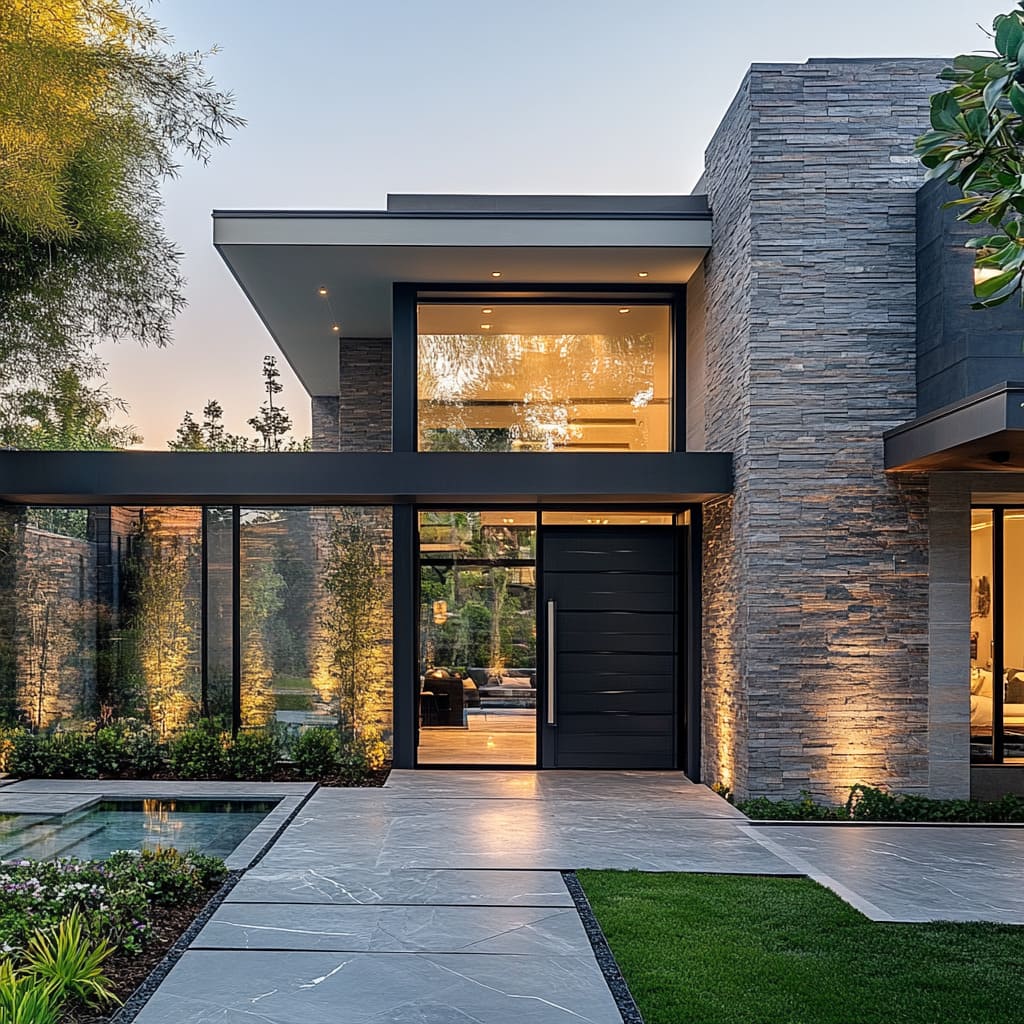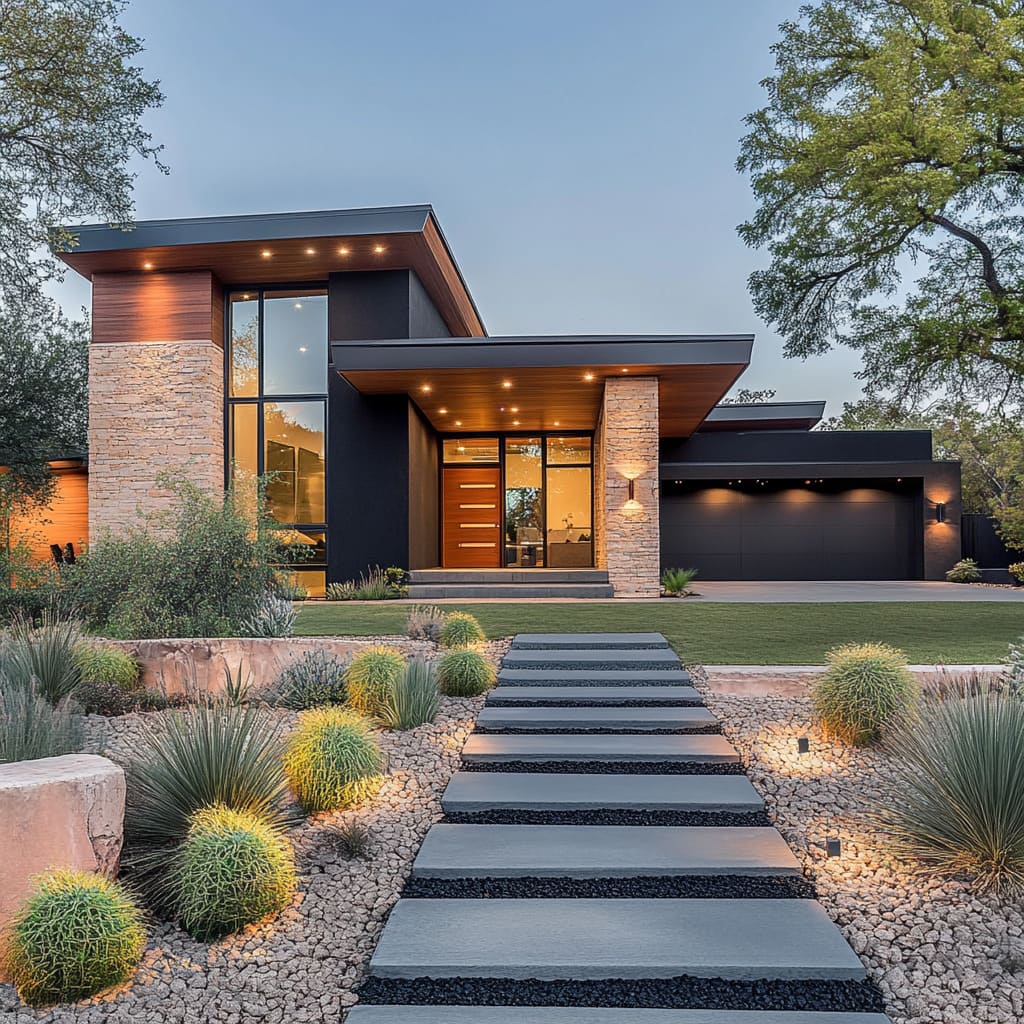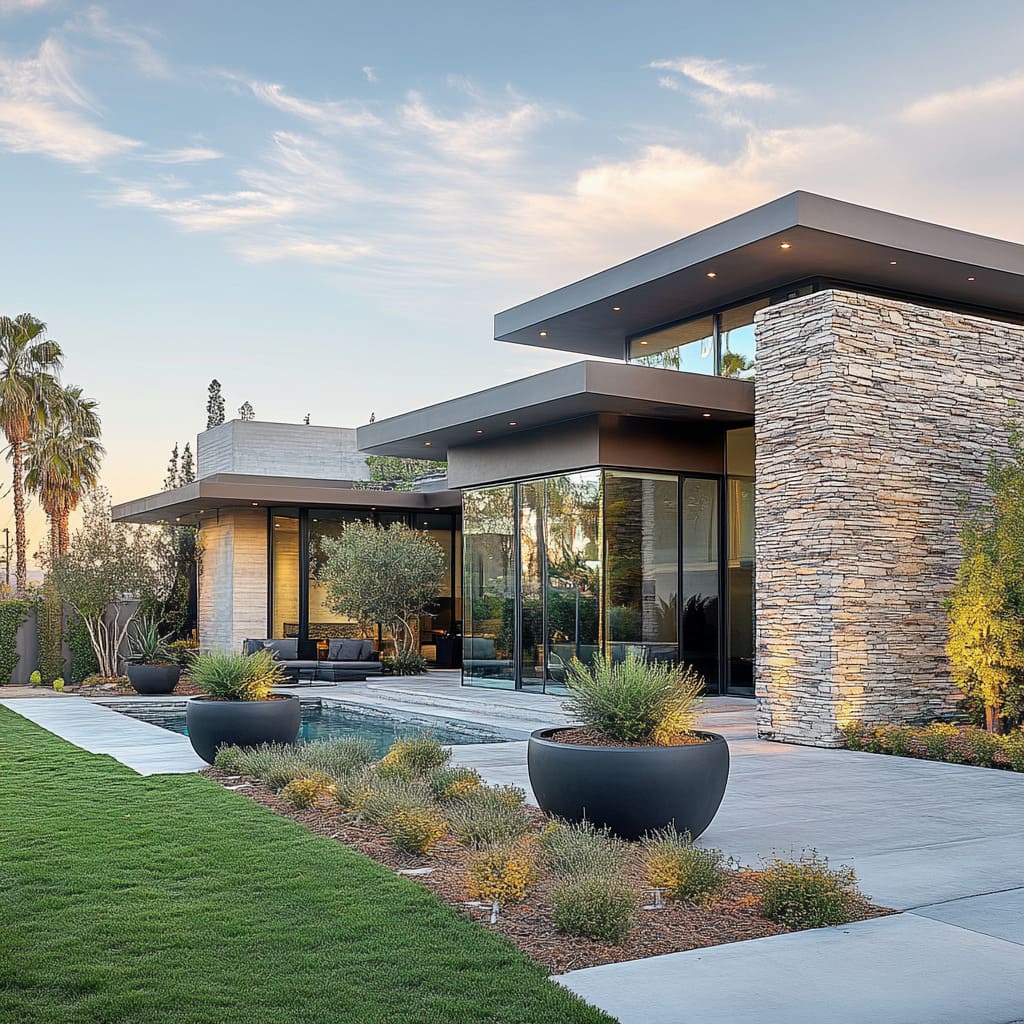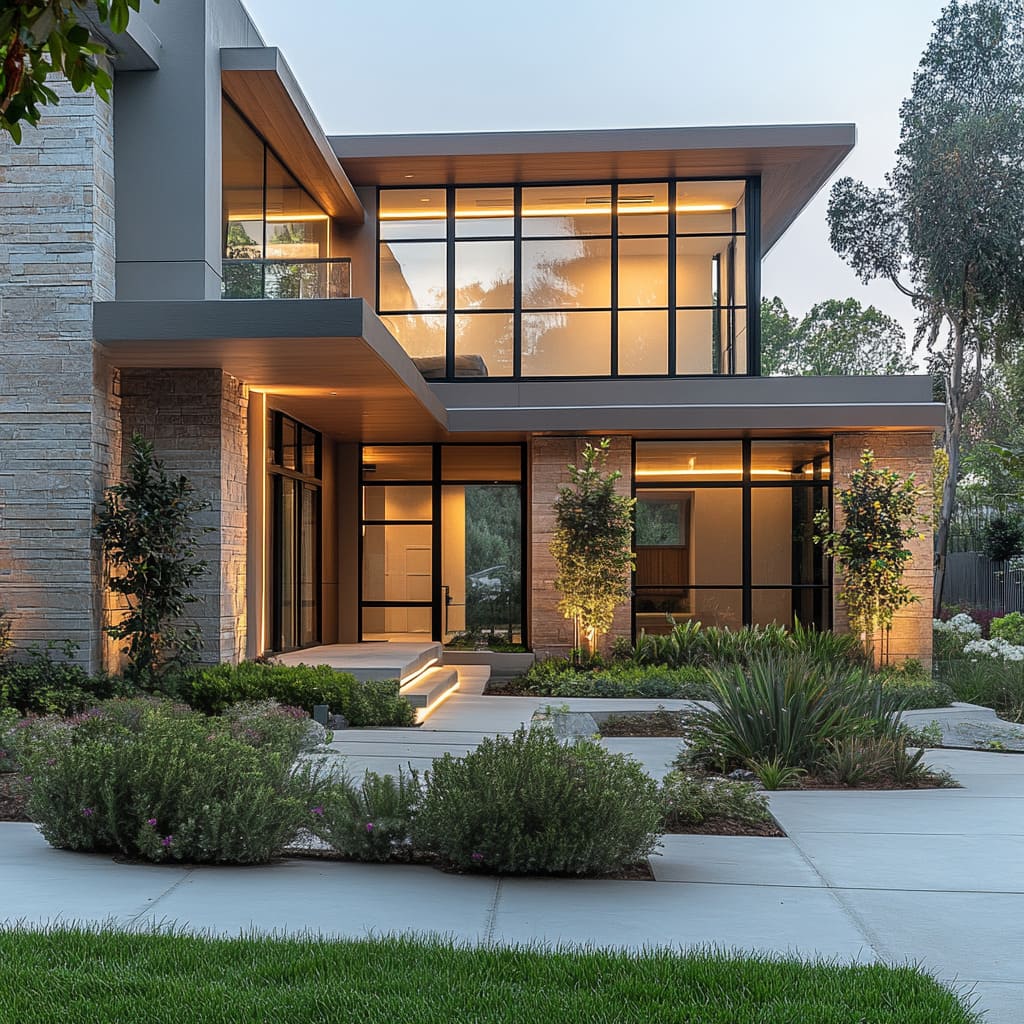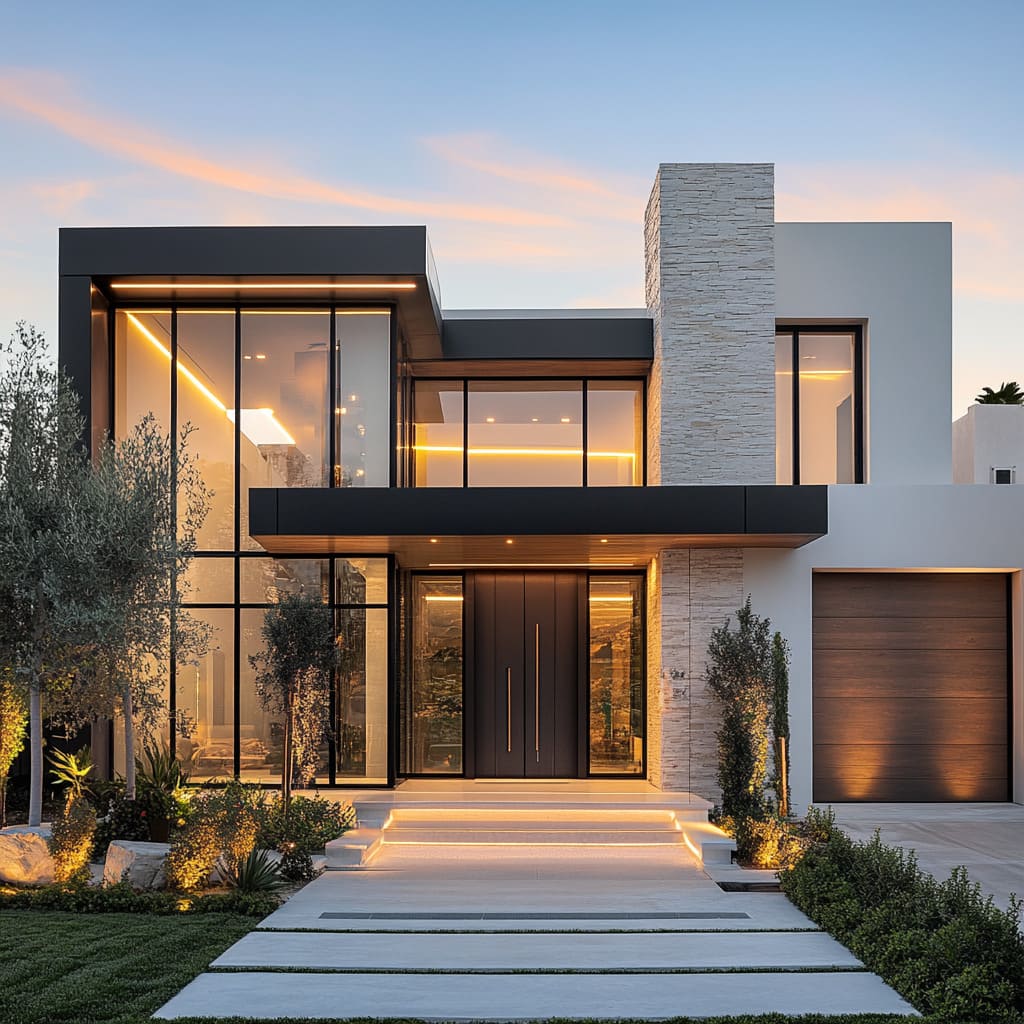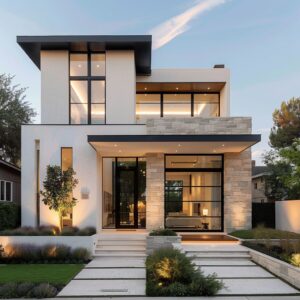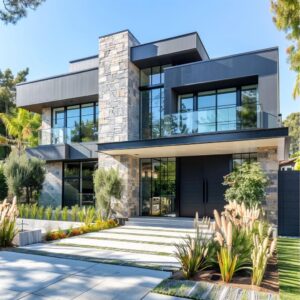Modern housing design has become a defining expression of contemporary lifestyles, combining clean aesthetics with functional innovation. From striking facades to carefully curated landscapes, these homes reflect a balance between minimalism and natural harmony.
Whether nestled in a quiet suburban neighborhood or standing out in an urban environment, modern exteriors prioritize materials, lighting, and landscaping to create spaces that are both visually appealing and practical. This article explores the core principles behind these standout designs, offering insights into the architectural elements, material choices, and landscaping strategies that make them so captivating.
With inspiration drawn from various regions and styles, this guide provides the essential ideas to help you design an exterior and yard that exudes sophistication while seamlessly blending with its environment.
Core Features of Modern House Exteriors
Architectural Shapes and Proportions
Modern house exterior design stands out for its deliberate use of clean lines and bold geometric forms, achieving a balance between simplicity and sophistication. Rectangular and cubic structures dominate, exuding a sense of order and modernity.
These shapes not only simplify construction but also provide an ideal base for introducing creative elements like cantilevered upper floors or extended rooflines. Such protrusions create visual depth, breaking up the monotony of flat facades while serving practical purposes like shading or defining outdoor spaces.
The interplay between vertical and horizontal elements is another defining aspect. Tall windows stretch upward, emphasizing height and grandeur, while broad horizontal rooflines anchor the structure, ensuring the design feels stable and cohesive.
The strategic use of symmetry in some homes ensures a classic, refined appeal, while asymmetry in others adds a touch of dynamism, creating points of interest that draw the eye and invite admiration. This careful combination of balance and contrast gives contemporary home design its timeless charm.
Materials and Finishes
The selection of materials in modern house architecture plays a vital role in defining its aesthetic and structural character. Glass dominates, with expansive panels framing the facade and creating an almost ethereal connection between the interior and the surrounding landscape.
These installations allow for abundant natural light, enhancing the interior atmosphere while simultaneously reflecting the outdoor environment, lending a lighter and more expansive feel to the structure.
Textured stone cladding adds warmth and character, contrasting with smooth stucco walls. This combination of rugged natural materials with sleek, minimalist finishes is a hallmark of modern design.
Complementing these materials are wooden accents, often in warm tones, which soften the overall look and add an organic touch. Metal elements, particularly aluminum or steel, frame windows and doors, lending an industrial edge that blends seamlessly with other features.
Finally, polished concrete, frequently used for pathways or feature walls, introduces an industrial yet refined aesthetic, ensuring every material choice contributes to the harmonious design.
Color Palette
A carefully curated color palette amplifies the visual appeal of modern exteriors. Neutral tones like white, gray, and beige dominate, providing a clean canvas that accentuates the textures and materials used in the construction.
These muted shades allow the architecture to stand out without overwhelming the viewer, creating a calm and balanced visual experience. Dark accents, often seen in window frames or roofing, inject subtle contrast, emphasizing key architectural features without detracting from the overall harmony.
The inclusion of natural wood or stone adds warmth to the otherwise cool palette, bridging the gap between modern minimalism and inviting comfort. This balance ensures the design remains approachable while retaining its contemporary edge.
Windows and Transparency
Transparency is a central theme in modern design, achieved through the thoughtful use of large, uninterrupted glass panels. These floor-to-ceiling installations create a seamless connection between the indoors and the outdoors, making the house feel expansive and open.
The transparency not only frames the surrounding landscape but also allows for creative lighting interplay, with sunlight streaming in during the day and warm indoor lighting shining outward at night. Frameless or slim-framed windows enhance this effect, ensuring the glass takes center stage without the distraction of bulky supports.
Corner windows, wrapping around two sides of a structure, are another standout feature, offering panoramic views and enhancing the feeling of immersion in the environment. These elements are not just practical; they add a sense of innovation and refinement that defines modern house exterior design.
Roof Design
Rooflines are more than just a functional aspect; they are a defining feature of modern house architecture. Flat roofs are a signature element, emphasizing horizontal lines and providing a sleek, uncluttered silhouette.
These roofs often extend outward to create overhangs that serve both aesthetic and functional purposes, offering shade and visual depth. Recessed lighting, integrated into the roof edges, further enhances the structure’s modern look.
By casting a soft glow onto the facade, this lighting creates a striking visual effect, especially at dusk. This subtle illumination highlights the architectural lines, drawing attention to the house’s design details while ensuring the exterior remains welcoming and well-lit.
Entrances
Entrances in contemporary home design are crafted to make a statement. Double-height entryways are common, creating an imposing yet inviting visual impression.
Oversized doors, often in matte finishes or warm wood tones, contribute to the minimalist aesthetic while adding a sense of grandeur. Recessed lighting plays a significant role here as well, accentuating the entrance and guiding visitors toward it.
The lighting not only highlights the pathway but also draws attention to the texture of surrounding materials, such as stone cladding or stucco. These thoughtful touches ensure that the entrance is not merely functional but a key architectural focal point.
By focusing on these design principles—clean lines, strategic materials, thoughtful color palettes, and harmonious integration of lighting and landscaping—you can create a modern house exterior that is as impressive as it is functional. The blend of transparency, balance, and natural elements ensures that the design stands out while remaining timeless and universally appealing.
Landscaping and Yard Design
Pathways and Driveways
Modern architecture homes often showcase meticulously crafted pathways and driveways that enhance the overall exterior design while ensuring functionality. Wide concrete slabs separated by green grass strips are a popular choice, offering a rhythmic, structured look that complements the clean lines of the house.
This design technique balances the rigidity of concrete with the softness of natural greenery, creating a visually pleasing composition that feels intentional and harmonious.
Stone pavers, often polished for a refined finish, bring a sophisticated touch to the pathways. These materials are frequently chosen to mirror or complement the facade’s textures, such as stone cladding or stucco.
For a touch of creative flair, asymmetrical walkway layouts are introduced. These irregular paths create contrast against the structured geometric forms of the house, adding depth and visual interest without overwhelming the overall aesthetic.
Plant Selection
Plant choices are integral to achieving the sleek, cohesive look typical of modern residential architecture. Low-maintenance greenery like boxwoods, succulents, and ornamental grasses is favored, as these plants offer structured, sculptural forms while requiring minimal upkeep.
Flowering shrubs, strategically placed, introduce subtle pops of color without detracting from the minimalist design language.
Layered planting is a key landscaping technique. Tall hedges often frame the property, providing privacy while enhancing the overall composition.
Medium-height plants add depth, forming a transition between the taller hedges and the ground-level greenery. Ground cover, such as creeping thyme or moss, introduces texture and ensures no space looks neglected.
Accent trees, particularly olive or palm varieties, are used to soften the house’s hard lines. Their strategic placement near entryways or as focal points in the yard creates a natural counterbalance to the structured facade.
Water Features
Incorporating water features into the yard design elevates the sense of sophistication and tranquility. Reflective pools, placed near entrances or backyard terraces, are a hallmark of modern landscaping.
These pools not only provide a serene focal point but also mirror the house and its surroundings, enhancing the visual depth of the property. Minimalist fountains are another favored choice.
These fountains often feature geometric designs that echo the clean lines of the house. Rather than dominating the landscape, they serve as subtle accents that reinforce the modern aesthetic.
The sound of flowing water introduces a dynamic yet soothing element, making outdoor spaces more inviting and tranquil.
Outdoor Lighting
Thoughtful lighting design plays a pivotal role in modern landscaping, ensuring the house and yard remain visually appealing long after sunset. Pathway lighting, achieved through recessed lights or modern bollards, ensures safe navigation while adding a sleek, sculptural element to the yard.
These lights often follow the contours of the pathways, highlighting their geometric precision. Wall washers, designed to cast light upwards or sideways, are frequently used to accentuate the textures of facade materials such as stone, wood, or stucco.
This technique draws attention to the craftsmanship of the exterior while creating a warm, welcoming ambiance. Uplighting for trees is another striking feature, as it adds vertical interest to the landscape.
By focusing light upward, this method highlights the natural forms of the trees and enhances the sense of depth in the yard.
Outdoor Living Areas
Modern residential architecture places significant emphasis on blending indoor and outdoor spaces, and the yard design reflects this seamless integration. Terraces and decks, often constructed with smooth wood or natural stone flooring, extend the living areas outward, providing functional spaces for relaxation or entertainment.
These materials are chosen for their durability and ability to harmonize with the overall aesthetic. Frameless glass railings are a common feature, ensuring unobstructed views of the surrounding landscape while maintaining safety.
These railings allow the architecture and landscaping to take center stage without visual interruption. Neutral-tone outdoor furniture with streamlined designs complements the minimalist approach, ensuring the focus remains on the house and its environment rather than the decor.
With a combination of structured pathways, layered greenery, dynamic water features, and strategic lighting, modern landscaping transforms the exterior of homes into cohesive, visually compelling spaces. These elements work together to amplify the architectural features of the house while creating a functional and inviting outdoor environment.
The key lies in maintaining balance—between structure and softness, functionality and beauty, and architecture and nature.
Design Ideas for Creating a Striking Modern House Exterior
Facade Design
When crafting the exterior of modern architecture homes, blending diverse materials is essential for visual interest and depth. A combination of stucco, natural stone, and sleek metal creates an engaging interplay of textures, giving the facade a sophisticated yet approachable appearance.
For instance, pairing smooth stucco with rugged stone cladding can add contrast, while metal accents around windows or as siding details introduce a contemporary flair. Dynamic architectural shapes enhance the structure’s overall aesthetic.
Incorporating cantilevers—where upper floors project outward—or wraparound windows adds dimensionality and breaks away from the monotony of flat surfaces. These elements create movement within the design, making the home appear both innovative and timeless.
Transparency also plays a critical role; expansive glass areas help blur the boundaries between indoor and outdoor spaces while ensuring privacy is maintained through strategic placement or frosted finishes.
Color Strategy
A refined color palette is the backbone of modern residential architecture. Sticking to neutral tones, such as shades of white, gray, or beige, ensures the facade remains timeless.
To complement this base, warm wood accents or dark metal elements can be used sparingly to create contrast. Wood softens the look, adding warmth, while darker hues highlight architectural features like rooflines or window frames.
Layered shades of the same color family can further enhance the design’s sophistication. For example, using multiple tones of gray—ranging from light to charcoal—creates subtle depth without overwhelming the eye.
This technique can be applied to both the facade and outdoor elements like planters or retaining walls.
Innovative Entrances
The entrance is the first impression of any home, and modern designs prioritize sleekness and functionality. Oversized doors crafted from materials like wood or metal provide a bold statement while maintaining a minimalist aesthetic.
Concealed handles or flush designs ensure the entrance aligns seamlessly with the overall style. Lighting is another critical aspect of entrance design.
Recessed lights placed around the doorway or accent lighting that frames the entry creates a welcoming glow and enhances the entrance as a focal point. These techniques highlight the architectural integrity of the design while ensuring practical visibility during evenings.
Rooflines
Flat rooflines are a hallmark of modern architecture homes, but their simplicity can be elevated with thoughtful additions. Extending roofs to include dramatic overhangs not only provides functional shading but also emphasizes the horizontal elements of the design.
These overhangs create visual balance, especially when paired with vertical architectural features like tall windows or textured stone panels. Incorporating sustainable elements, such as green roofs or solar panels, adds another layer of functionality.
Green roofs can reduce heat absorption and offer a visually pleasing natural element, while solar panels align with eco-conscious trends. Both options merge practicality with aesthetics, ensuring the home remains relevant in modern design landscapes.
Landscaping
The exterior design of a home extends into the surrounding yard, where landscaping should echo the architectural language of the house. Geometric planting beds mirror the clean lines of the facade, creating a cohesive visual narrative.
For example, rectangular or angular beds filled with succulents or ornamental grasses maintain the minimalist aesthetic while introducing organic forms. Lighting integrated into planters is a subtle yet impactful addition.
These lights can cast a soft glow upward, highlighting the greenery while ensuring the yard is usable after sunset. Drought-tolerant plants, like succulents and lavender, are practical choices that require minimal upkeep, making them ideal for modern designs focused on efficiency and sustainability.
Lighting Design
Lighting plays a pivotal role in enhancing the exterior’s visual appeal. Embedding LEDs in pathways, roof edges, or even planters provides a soft, ambient glow that accentuates architectural features.
For instance, lights along pathways can guide visitors while seamlessly blending into the design. Programmable lighting systems offer versatility by allowing adjustments in brightness or color temperature throughout the day.
During evening hours, warm lighting tones can create a cozy atmosphere, while cooler tones emphasize the modernity of the structure. This flexibility ensures the exterior remains striking at all times, catering to both functional needs and aesthetic goals.
By blending carefully chosen materials, thoughtful lighting, and cohesive landscaping, you can create an exterior that mirrors the sophistication of modern residential architecture while maintaining practical functionality. Each element, from the facade design to the yard layout, contributes to a unified and visually compelling home.
Key Insights to Take Away
Balance of Elements
The hallmark of a contemporary modern house lies in achieving harmony between its elements. Striking homes don’t simply combine materials—they juxtapose textures and tones to create visual balance.
For instance, sleek metal frames paired with warm wood panels or textured stone cladding create a composition that is both dynamic and cohesive. Geometric forms, whether in the architecture or landscaping, are designed to complement rather than compete with each other, resulting in a seamless flow that avoids visual clutter.
Thoughtfully designed lighting highlights these details, ensuring every feature contributes to the overall aesthetic.
In modern house architecture design, balance extends beyond materials. The interplay between horizontal and vertical lines brings depth and rhythm to the facade.
A cantilevered second story, for example, offers a counterpoint to grounded elements like stone-clad walls or lush landscaping. This sense of equilibrium is not accidental but the result of precise planning to ensure no single element overwhelms the design.
Integration of Nature
Modern homes redefine the relationship between built environments and nature by treating landscaping as an integral part of the design. Rather than acting as a separate feature, greenery and water elements become architectural extensions.
Low-maintenance plants, such as succulents, ornamental grasses, or strategically placed trees, are selected not only for their aesthetic appeal but also for their ability to soften the home’s sharp edges. For example, tall hedges can frame the structure, while accent trees like olive or Japanese maples add vertical interest.
Water features, whether reflective pools or geometric fountains, are often placed near entrances or patios, creating a calming visual and auditory contrast to the structure’s solidity. The integration of these natural elements ensures the home feels rooted in its environment, enhancing the overall impression of modernity and sophistication.
Focus on Functionality
Every element in a well-designed home serves a dual purpose, combining beauty with practicality. Overhangs, for example, are not merely architectural statements; they provide shade, reduce glare, and protect the home from harsh weather conditions.
Similarly, expansive glass panels are celebrated not just for their transparency but for their ability to flood interiors with natural light while offering uninterrupted views.
Lighting is another aspect where function meets form. Recessed LEDs in pathways and rooflines illuminate key features while ensuring safety and usability.
Frameless glass railings maintain a minimalist aesthetic while providing essential security for outdoor terraces. This focus on functionality ensures that the home remains as practical as it is visually striking, catering to both everyday needs and aesthetic aspirations.
Attention to Detail
What elevates an ordinary design to an extraordinary one is often the smallest of details. The precise junctions where materials meet—whether it’s stone against metal or stucco against glass—are meticulously crafted to appear seamless.
This level of detail not only enhances the home’s appearance but also reflects the quality of construction.
Hidden frames for windows and doors further enhance the minimalist aesthetic, allowing uninterrupted lines that emphasize the home’s geometry. Recessed lighting, whether in ceilings, walls, or pathways, eliminates bulky fixtures and creates a soft, ambient glow that accentuates the materials’ textures.
Each of these details might seem subtle in isolation, but together, they create a design that feels cohesive and intentional.
The Essence of Modern Design
In contemporary modern house design, the interplay of balance, nature, functionality, and detail creates a home that feels effortlessly stylish yet undeniably functional. From the selection of materials to the integration of lighting and landscaping, every decision is guided by a philosophy of cohesion and purpose.
These insights offer a roadmap for creating homes that are not only beautiful but timeless, resonating with the principles of modern residential architecture across various regions and inspirations.
Conclusion
Creating the best modern home exterior design requires a commitment to simplicity, precision, and a seamless connection between the built structure and its surroundings. The principles highlighted throughout this article emphasize the importance of clean lines, harmonious material combinations, and thoughtful landscaping that complements the architecture rather than competing with it.
By prioritizing high-quality materials such as natural stone, glass, and metal, paired with a carefully selected neutral color palette, you can establish a timeless aesthetic that feels grounded yet innovative. Strategic lighting, both exterior and integrated into landscaping, elevates the design further, adding depth and creating dramatic yet functional visual effects during the evening hours.
Landscaping plays a pivotal role in balancing the structure’s bold geometry with softer natural elements. Choosing low-maintenance greenery, accent trees, and water features ensures the yard not only aligns with the home’s aesthetic but also becomes an extension of its modern character.
Whether taking inspiration from regional designs or aiming for a universally modern appeal, the key lies in attention to detail and a cohesive approach. Each design decision—from the selection of materials to the placement of lighting and greenery—works together to create a residence that embodies sophistication and architectural integrity.
With these principles in mind, your modern home can achieve an aesthetic that is both visually stunning and deeply functional, standing as a testament to modern architectural excellence.
